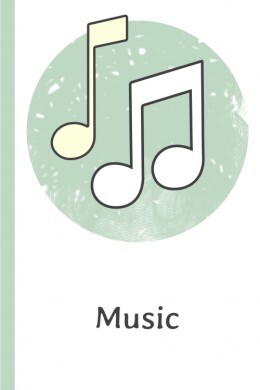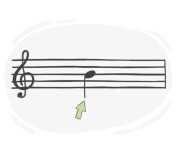Musika - Notasyong musikal
Dito matututo ka ng ilang mga salitang Ingles na may kaugnayan sa notasyong musikal tulad ng "sharp", "fermata", at "glissando".
Repasuhin
Flashcards
Pagbaybay
Pagsusulit


buong nota
Ang mang-aawit ay naghawak ng buong nota sa rurok ng kanta, na humihila sa madla gamit ang emosyonal na intensity ng napapanatiling tono.

tono
Ang kanta ay nasa tono ng C major, na nagbibigay sa ito ng maliwanag at nakakagalak na tunog.

gitnang C
Itinugma niya ang tono ng kanyang gitara sa gitnang C na tinugtog sa isang keyboard.

natural
Pinapaalala ng konduktor sa orkestra na bantayan ang natural na sign sa musika para tumugtog ng tamang pitch.

oktaba
Ang saklaw ng mang-aawit ay umabot sa tatlong oktava, na humanga sa mga hukom.

kord
Ang mga daliri ng musikero ay mabilis na gumalaw upang bumuo ng bawat chord sa fretboard.

sharp
Ang pagdaragdag ng isang sharp ay nagbago sa tono ng melodiya, na nagbigay dito ng mas masiglang tunog.

kalahating nota
Bilang guro sa musika, tinuruan niya ang mga estudyante na bilangin nang tumpak ang mga beats kapag tumutugtog ng half note.

quarter note
Bilang isang percussionist, tumutok siya sa katumpakan ng kanyang mga hampas, tinitiyak na ang bawat quarter note ay tinutugtog nang malinaw at pare-pareho.

toniko
Pagkatapos tugtugin ang dominant chord, ang resolution pabalik sa tonic ay nagbigay ng kasiya-siyang konklusyon sa musical phrase.

linya ng sukat
Ang bar line ay nagpapahiwatig kung saan nagtatapos ang isang sukat at nagsisimula ang susunod.

susi
Sa medieval music notation, ang clef na sol ay kahawig ng isang maliit na titik na "g" at nagpapahiwatig ng posisyon ng nota na "G" sa staff.

tablature
Ang mga online na mapagkukunan ay nag-aalok ng malawak na hanay ng tablature para sa mga popular na kanta, na ginagawa itong naa-access para sa mga musikero na nagturo sa sarili.

ikawalong nota
Habang tumataas ang tempo, tinugtog ng piyanista ang mabilis na sunod-sunod na eighth notes nang may liksi at kontrol.

labing-anim na nota
Ginamit ng kompositor ang labing-anim na nota upang bigyan ng enerhiya at momentum ang komposisyon.

tatlumpu't dalawang nota
Habang tumataas ang tempo, ginampanan ng mga musikero ang masalimuot na ritmo ng tatlumpu't dalawang nota nang may kasanayan at katumpakan.

animnapu't apat na nota
Ginamit ng kompositor ang animnapu't apat na nota upang magdagdag ng rhythmic complexity at intensity sa musical texture.

sinag
Ang mga beam ay nagpapadali sa pagbasa ng mga kumplikadong ritmo.

karaniwang oras
Ang pianist ay nag-improvisa ng syncopated rhythm sa loob ng balangkas ng common time, na nagdagdag ng interes sa musical texture.

slur
Ang clarinetist ay tumutok sa pagkamit ng isang maayos na paglipat sa pagitan ng mga nota sa pamamagitan ng pagmamasid sa mga slur sa musical passage.

kuwartong tono
Tinalakay ng klase sa teorya ng musika ang paggamit ng quarter tone sa iba't ibang kultural na konteksto, na nagbibigay-diin sa kanilang kahalagahan sa mga tradisyon ng musika sa mundo.

hudyat ng pagbabago
Isang accidental ang lumitaw bago ang F note, na nagpapalit nito sa F♯ para sa sukat.

arpehiyo
Ang jazz improvisation ay madalas na nagsasangkot ng paggamit ng arpeggio upang mag-navigate sa mga chord progression nang may fluidity at creativity.

trill
Ang trill sa aria ng soprano ay nagdagdag ng isang flourish ng embellishment, na nagpapahusay sa vocal performance.

halaga ng nota
Sa pamamagitan ng pag-master sa mga halaga ng nota, ang mga musikero ay maaaring epektibong makipag-ugnayan sa ritmikong istruktura ng isang piyesa at i-synchronize ang kanilang pagtugtog sa iba pang mga performer.












































